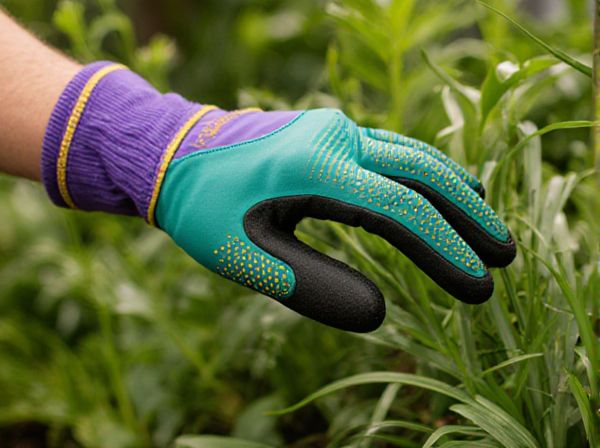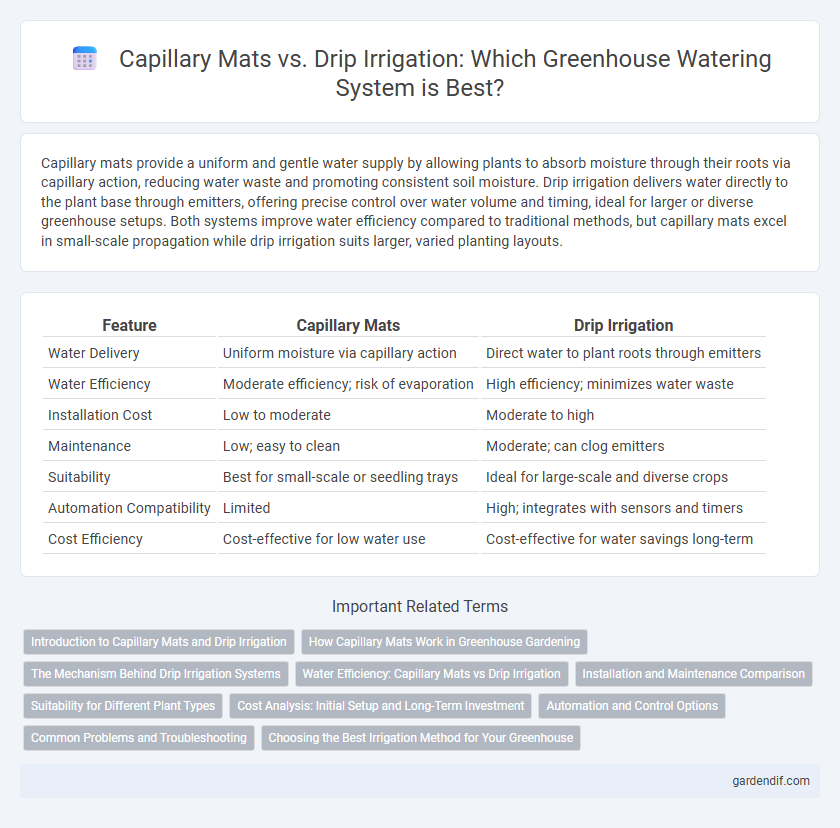
Capillary mats vs drip irrigation Illustration
Capillary mats provide a uniform and gentle water supply by allowing plants to absorb moisture through their roots via capillary action, reducing water waste and promoting consistent soil moisture. Drip irrigation delivers water directly to the plant base through emitters, offering precise control over water volume and timing, ideal for larger or diverse greenhouse setups. Both systems improve water efficiency compared to traditional methods, but capillary mats excel in small-scale propagation while drip irrigation suits larger, varied planting layouts.
Table of Comparison
| Feature | Capillary Mats | Drip Irrigation |
|---|---|---|
| Water Delivery | Uniform moisture via capillary action | Direct water to plant roots through emitters |
| Water Efficiency | Moderate efficiency; risk of evaporation | High efficiency; minimizes water waste |
| Installation Cost | Low to moderate | Moderate to high |
| Maintenance | Low; easy to clean | Moderate; can clog emitters |
| Suitability | Best for small-scale or seedling trays | Ideal for large-scale and diverse crops |
| Automation Compatibility | Limited | High; integrates with sensors and timers |
| Cost Efficiency | Cost-effective for low water use | Cost-effective for water savings long-term |
Introduction to Capillary Mats and Drip Irrigation
Capillary mats are passive irrigation systems using porous materials to evenly distribute water through capillary action, ideal for consistent moisture in greenhouse seed trays and containers. Drip irrigation delivers water directly to the root zone via emitters, enabling precise control over water volume and timing, reducing waste and promoting plant health. Both systems optimize water use efficiency but differ in application methods and scalability for various greenhouse setups.
How Capillary Mats Work in Greenhouse Gardening
Capillary mats work in greenhouse gardening by providing a consistent and uniform moisture source directly to the plant roots through a porous fabric that absorbs and retains water. These mats ensure efficient water distribution, reducing evaporation and runoff compared to drip irrigation systems. They create an ideal humid microenvironment that promotes healthy root growth and minimizes water stress.
The Mechanism Behind Drip Irrigation Systems
Drip irrigation systems deliver water directly to plant roots through a network of tubes, emitters, and valves, ensuring precise moisture control and efficient water usage. This mechanism minimizes evaporation and runoff by releasing water slowly at a consistent rate, promoting healthier plant growth and reducing overall water consumption. In contrast to capillary mats, which rely on passive water absorption, drip irrigation provides targeted irrigation that can be customized for different crop needs within the greenhouse environment.
Water Efficiency: Capillary Mats vs Drip Irrigation
Capillary mats provide uniform water distribution through capillary action, reducing water wastage by maintaining consistent soil moisture levels, ideal for small-scale greenhouse setups. Drip irrigation delivers precise water directly to plant roots through emitters, enhancing water-use efficiency in larger, commercial greenhouse operations by minimizing evaporation and runoff. Compared to capillary mats, drip irrigation generally offers higher water efficiency and better adaptability to varied crop needs in controlled environments.
Installation and Maintenance Comparison
Capillary mats offer a simple installation process by laying flat under pots, requiring minimal setup compared to drip irrigation systems that involve installing tubing, emitters, and timers. Maintenance for capillary mats primarily involves regular cleaning to prevent algae and blockages, while drip irrigation demands ongoing checks for emitter clogs, leaks, and system pressure adjustments. The ease of installation and lower maintenance complexity make capillary mats a convenient choice for smaller or less technical greenhouse setups.
Suitability for Different Plant Types
Capillary mats provide uniform moisture ideal for small pots, seedlings, and delicate plants requiring consistent hydration, while drip irrigation suits a wide range of plant types, including larger crops and spaced plants, by delivering customizable water amounts directly to the root zone. Capillary mats are less effective for deep-rooted plants due to surface-level moisture, whereas drip irrigation supports deep watering, promoting healthy root development. Greenhouse growers select irrigation methods based on plant species, growth stage, and water requirements to optimize plant health and resource efficiency.
Cost Analysis: Initial Setup and Long-Term Investment
Capillary mats require a lower initial investment due to their simple installation and minimal equipment needs compared to drip irrigation systems, which involve pumps, tubing, and emitters. Over time, drip irrigation offers greater water efficiency and targeted delivery, often reducing water and nutrient costs despite higher upfront expenses. Long-term investment in drip irrigation can lead to improved crop yields and lower labor costs, potentially offsetting initial setup costs more effectively than capillary mats.
Automation and Control Options
Capillary mats offer passive water distribution with limited automation, relying primarily on consistent moisture levels and manual monitoring, whereas drip irrigation systems provide advanced automation and precise control through timers, sensors, and smart controllers. Drip irrigation allows customizable watering schedules based on plant needs, environmental conditions, and soil moisture data, enhancing water efficiency and reducing labor. Integrating IoT technology with drip irrigation further supports real-time adjustments and remote management, making it ideal for greenhouse automation.
Common Problems and Troubleshooting
Capillary mats often face issues like uneven water distribution and mold growth due to excess moisture buildup, requiring regular checks for proper drainage and humidity control. Drip irrigation systems commonly experience clogging of emitters and inconsistent water pressure, necessitating routine flushing of lines and filter maintenance. Both systems demand vigilant monitoring to prevent overwatering and ensure optimal plant health in greenhouse environments.
Choosing the Best Irrigation Method for Your Greenhouse
Capillary mats provide uniform moisture distribution and are ideal for small-scale greenhouse setups, offering water efficiency and root zone consistency. Drip irrigation delivers targeted water directly to plant roots, enabling precise control over moisture levels and nutrient delivery, which is beneficial for larger or diversified crop cultivation. Selecting the best irrigation method depends on greenhouse size, crop type, water conservation goals, and maintenance preferences.
Capillary mats vs drip irrigation Infographic

 gardendif.com
gardendif.com